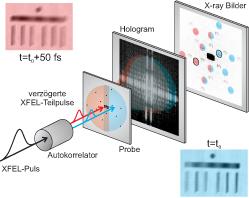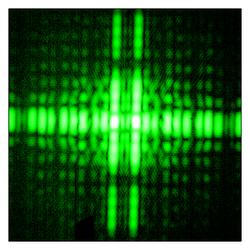The central part of the recorded hologram on a logarithmic intensity scale (Courtesy of S. Eisebitt et al.).

Experiment at FLASH: the Fourier transform holography (FTH) was performed in transmission geometry in a mask-based approach (Courtesy of S. Eisebitt et al.).
A team of scientists from four German institutes including HASYLAB/DESY, led by HZB/TUB researchers, recorded two images of a micro-object with soft X-ray pulses, which were separated by only 50 femtoseconds. The measurement of this "molecular movie" was performed at beamline BL3 at FLASH at DESY. "Molecular movies" will help to understand fundamental processes in nature, e.g. they show how molecules behave during a chemical reaction.
The authors showed that a superposition of two holograms of an object, which were produced by two FEL pulses in extreme quick succession, can be recorded and reconstructed afterwards. This concept allows to overcome the readout time limitations of two-dimensional area detectors
and makes it possible vary the time delay between the pictures over the entire femtosecond regime. FLASH pulses with a wavelengh of λ = 23.5 nm and a pulse duration of estimated 30 fs were used for this experiment.
(....from paper and press releases)
The results were published in: Nature Photonics
5, 99–102, (2011), doi:10.1038/nphoton.2010.287, C.M. Günther et al. 'Sequential femtosecond X-ray imaging'.
| Further Information |






